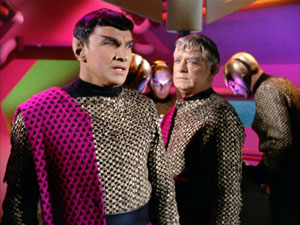 Now this is a good episode. “Balance of Terror” is the tale of the Enterprise‘s first encounter with a Romulan vessel. Before this encounter, as we learn, no human or Romulan had ever seen each other. The two races had fought a war with primitive “atomic weapons” (so primitive they weren’t even called “nuclear”), and established a treaty along a Neutral Zone buffer between their regions of influence. So much of the well-known Star Trek mythology is established in this episode for the first time, it would be difficult for it not to be a classic episode.
Now this is a good episode. “Balance of Terror” is the tale of the Enterprise‘s first encounter with a Romulan vessel. Before this encounter, as we learn, no human or Romulan had ever seen each other. The two races had fought a war with primitive “atomic weapons” (so primitive they weren’t even called “nuclear”), and established a treaty along a Neutral Zone buffer between their regions of influence. So much of the well-known Star Trek mythology is established in this episode for the first time, it would be difficult for it not to be a classic episode.
The story opens in a wedding ceremony, with Kirk stating his happy position of having the authority to marry couples as the ship’s captain. An odd thing is that everyone at the ceremony is in Starfleet uniform. Including the bride, Angela Martine, whose only concession to tradition is some white feathers arranged in her hair. She is being given away by Scotty, for a reason never explained. Alas, the ceremony is interrupted by a red alert and battle stations, with the news that the nearby Earth Outpost 4 has been attacked. Angela and her fiancé Robert Tomlinson return to their posts in the weapons control room.
Spock shows a map of the Outposts and the Neutral Zone – a two-dimensional map showing a linear border with 8 human outpost stations along it. Of course this is a simplification for television, as a space border must be a surface, and would be considerably more penetrable than a linear boundary on a 2D map. We learn that Kirk’s orders with regards to the Neutral Zone are “inviolable”: he must not enter it under any circumstances; the Enterprise and all the Outposts are to be regarded as expendable, rather than risk any incursion into the Zone. Of course, Kirk later ignores this and chases the Romulan war craft into the Zone.
We meet Lieutenant Stiles, serving as navigator in this episode. He hates the Romulans, because they killed some of his family. He makes the odd statement that there may be Romulan spies on board the Enterprise – rather a big reach given there’s no evidence presented at any stage that any Romulans have ever breached the Neutral Zone before the present warship.
The ship destroys Outpost 4 and turns on the Enterprise, and we hear the evocative Romulan/Klingon attack music for the first time in the series. The ship becomes invisible, “deflecting light rays around itself”, but Spock can somehow track it on his sensors. This physics-bending state of affairs is never explained. One would expect a cloaking device for a spaceship to concentrate on deceiving electronic sensing, not eyeballing, or rather to achieve both or be essentially useless. Spock gets a view on to the bridge of the Romulan vessel, revealing its commander is… his father!!
Wait no, that’s Mark Lenard, who would later go on to play Spock’s father, playing the Romulan commander, who is never named. We learn the Romulans resemble Vulcans, which primes Stiles to insinuate that Spock may be a Romulan spy. We later see several scenes on board the Romulan vessel (that the Enterprise crew don’t see), during which it becomes clear that the Romulan Empire is essentially Ancient Rome in Space, with a Praetor back home, and a Centurion as second-in-command on board the ship. And of course there’s the classical allusion to Romulus, founder of Rome.
What follows is, essentially, a game of World War II submarine cat-and-mouse. There’s a tactical briefing during which Kirk pushes around a huge, black, leather-bound book on a table for no apparent reason. There are some shots traded and damage taken. And there’s even a silent running stand-off, waiting for the other ship to make a mistake. They even whisper during this phase, apparently to avoid making any sounds that the other ship, across the vacuum of space, could pick up…
The Romulans flee to a comet tail, which obscures vision and sensors. That’s one unrealistically dense comet tail. The Enterprise fires a bunch of “phasers”, but these actually look like depth charges photon torpedoes. The stand-off is broken when Spock accidentally touches an alarm button, causing Stiles to go ballistic with unconcealed bigotry. Shots are exchanged and damage occurs, with Yeoman Rand making what must be her last appearance grabbing Kirk for comfort in the face of death. Stiles leaves to help in the weapons room, and Uhura takes his place at the bridge navigation/weapons console – she has shown a lot of skills already! When more damage is sustained, Stiles gets in trouble and Spock rescues him, removing Stiles’ bigotry. The Romulans are defeated and self-destruct rather than surrender. The only casualty on board the Enterprise is, inevitably, Tomlinson. Angela is stoic in her mourning and Kirk is left to ponder the horrors of submarine interstellar warfare.
Body count: Entire personnel of Earth Outposts 2, 3, 4, and 8, including Commander Hansen of outpost 4; entire crew of Romulan Bird of Prey, including commander and centurion; Lieutenant Tomlinson.
Tropes: Wedding Smashers, 2-D Space, Space Cold War, Almost Dead Guy, Invisibility Cloak, Space Romans, Screw The Rules, I’m Doing What’s Right, Space Is An Ocean, Sub Story, Silent Running Mode, Space Does Not Work That Way, Worthy Opponent, It Has Been An Honor, Not So Different
(Image © 1966 Paramount Studios, used under Fair Use.)

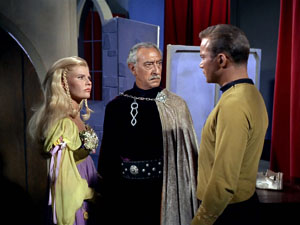 Now we reach an episode that I remembered virtually nothing about: “
Now we reach an episode that I remembered virtually nothing about: “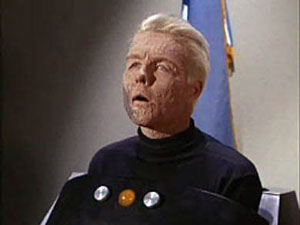 The only two-part episode in the entire series, “
The only two-part episode in the entire series, “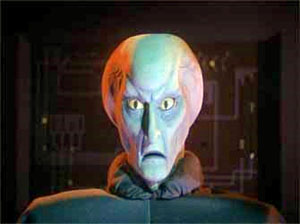 Before launching into this one, I had to decide whether to change the spelling to Australian English, or use the original American spelling of this episode title: “
Before launching into this one, I had to decide whether to change the spelling to Australian English, or use the original American spelling of this episode title: “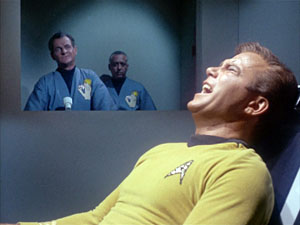 This is the first episode for which I couldn’t recall anything about it from the title, before watching it again. So I figured “
This is the first episode for which I couldn’t recall anything about it from the title, before watching it again. So I figured “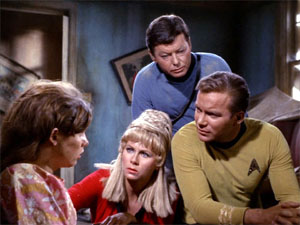 I wasn’t looking forward to
I wasn’t looking forward to 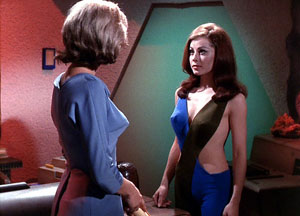 Nurse Christine Chapel plays a big role in
Nurse Christine Chapel plays a big role in 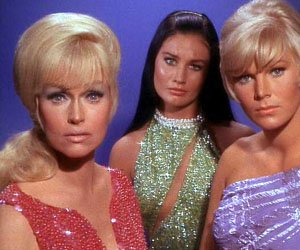 Wow, I’m ripping through these episodes! I don’t normally watch DVDs this frequently, but I feel like I’m getting on a bit of a roll. Anyway, on to “
Wow, I’m ripping through these episodes! I don’t normally watch DVDs this frequently, but I feel like I’m getting on a bit of a roll. Anyway, on to “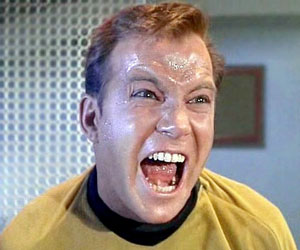 Ah, the transporter accident. Transporters were one of the great plot devices that Star Trek gave to television. This episode begins with one of the myriad possible forms of transporter failure, and a particularly odd one. Rather than simply killing Kirk or scattering his component molecules to all corners of the galaxy, it splits him into two halves – a “good” half and and “evil” half.
Ah, the transporter accident. Transporters were one of the great plot devices that Star Trek gave to television. This episode begins with one of the myriad possible forms of transporter failure, and a particularly odd one. Rather than simply killing Kirk or scattering his component molecules to all corners of the galaxy, it splits him into two halves – a “good” half and and “evil” half.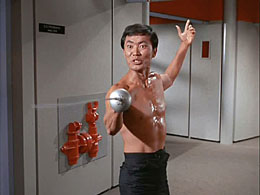 Ah, now this feels like Star Trek as we know it. The fourth episode to air (and the 7th produced), the series has now gotten into stride, and all the familiar elements are now in place. Nurse Christine Chapel makes her first appearance, completing the regular cast (with the exception of the later addition of Chekov), and she gets a dramatic scene with Spock in which she admits her love for him (under the influence of an inhibition-removing space disease).
Ah, now this feels like Star Trek as we know it. The fourth episode to air (and the 7th produced), the series has now gotten into stride, and all the familiar elements are now in place. Nurse Christine Chapel makes her first appearance, completing the regular cast (with the exception of the later addition of Chekov), and she gets a dramatic scene with Spock in which she admits her love for him (under the influence of an inhibition-removing space disease).